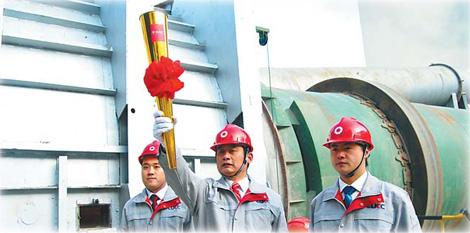
The recently-completed 4,800-ton raw construction material production line.
As demand for raw construction materials still continues to grow in the earthquake-battered Beichuan county, part of Sichuan province, at least part of the solution is set to be provided earlier this month opening of a new cement facility - the single largest industrial project to be undertaken in the area.
The cement plant, designed to have a daily production capacity of 4,800 tons, has been developed by the China United Cement Corp (CUCC), the nation's second-largest cement manufacturer. The company has invested 780 million yuan in the project, a vital asset for the county, which was devastated by the 7.8 magnitude earthquake on May 12, 2008.
To meet the demand for cement from the infrastructure re-construction projects across the area, CUCC began work on the new facility early in 2009. It has taken them just 10 months to complete work on the factory and its production line.
The plant began to produce cement in the first week of January and will reach an annual production capacity of two million tons.
Speaking at the opening ceremony, Cui Xingtai, president of CUCC, said: "The construction of the project took place under difficult conditions and encountered many challenges, including the risks of after-shocks and hazardous mud flows."
Welcoming the new facility, Xiong Bilin, director of the industrial bureau of the National Development and Reform Commission, said: "The supply of high-quality construction materials is a key issue for the success of post-quake reconstruction."
As well as meeting current demands, the company also emphasized that it had adopted environmental-friendly dry processing technology to reduce the emission of harmful dry powders.
The new facility is also equipped with a low temperature waste heat power generation system with a 9 mega-watts capacity, in order to make full use of the exhaust heat of the cement processing line. This waste heat power generation system has been designed to save 20,700 tons of standard coal usage and reduce CO2 emissions by 57.500 tons every year. It can also produce 61.88 million kilowatts of electricity annually.
Song Zhiping, president of the China National Building Material Corp, the parent company of CUCC, said the company attaches great emphasis to environmental protection measures and is committed to not exposing the local community to pollutants.
Addressing attendees at the opening event, Lei Qianzhi, chairman of the China Cement Association said: "Reconstruction throughout Sichuan has driven the demand for cement and attracted considerable investment to this industry, however, we need to be mindful of the need to control the capacity of cement production in this area following the reconstruction period."
Lei proposed that CUCC should take a leading role in acquiring small cement plants in Mianyang - the Sichuan county Beichuan falls under the jurisdiction of - and drive the restructuring of the region's cement industry.





